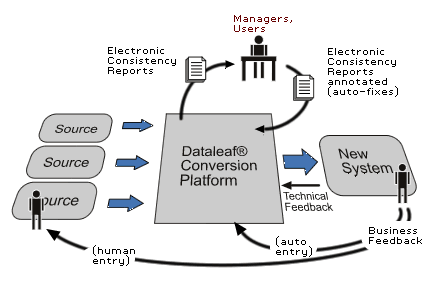
Dataleaf Technologies, Inc: HR System migration, archiving, analysis, modeling, interim HRIS
Dataleaf® Conversion Process (page 2)
[continued from page 1]
Task 2: Standard Conversion & Testing
This is the familiar test conversion cycle, common to all system migration projects. In a typical full cycle, a quantity of source data is passed through the conversion engine, introduced into the target environment, and loaded into the target (new system) environment.

Task 2: Standard Conversion & Testing
The DCP implements this conversion and testing cycle in a fairly traditional way to support endpoint auditing.
The Platform provides additional features to make analysis easier. Specifically:
- A collection of consistency tests, which attempt to drive out data problems by detecting inconsistencies between the same data element in different legacy sources, and between different fields in the same source.
- An analysis (and a complete image) of all output values of the conversion process, all fields, rolled up in a convenient form for sanity checking and lookup. This is available instantly, and does not depend on a data load into the new system.
- Facilities for automated data mapping with its plug-in mapping tool Datamapper™ (not shown in the diagram). Datamapper™ is an application that knows all legacy values, and all legal values in the new system (customization supported). It can be directly manipulated by client analysts or supervisors.
A Typical Sequence of Events for Dataleaf® Conversion Platform 'Standard Conversion' :
- In most projects this cycle is a weekly or biweekly event. In general, the limiting factor is logistic: that is, how long it takes to assemble a correct legacy system data load from the necessary sources. Even when this is not so, it is undesirable to try to make corrections on a 'moving target' -- so a weekly or biweekly legacy system data load is pretty much the limit
- The 'legacy system' is often composed of a large number of component data sources, including those handled by 3rd party administrators. At system migration time, redundancy is good, since the Dataleaf® Conversion Platform comparison tests can use redundancy to root out even quite subtle data errors.
- Concurrently with one 'Standard Conversion' cycle, several iterations of the 'Virtual Conversion' cycle are usually taking place. The distinction is transparent to the client.
Benefits of using the Dataleaf® Conversion Platform for the 'Standard Conversion Cycle' :
- There is no need to specify diagnostic reports for sanity checking or consistency checking. These have been created, over the years, in great numbers. The client task is simply to eliminate those which are less relevant to the client's particular needs
- Immediate feedback is available, early in the project, on the integrity of the full data load process. Particularly for clients whose own DBA resources will assume responsibility for the new system, this is very useful.
- Convenient sanity-checking tools for output values are immediately available, completely independent of the new system data load, user interface, and setup parameters.
- 50% of all data fixes can be permanently resolved just by annotating the Dataleaf® Conversion Platform Consistency Reports. These annotations are directly introduced into the Platform, and triggered by all subsequent conversion cycles (generating an audit trail each time they are triggered)!
- Conversion Process:
- .. page 1
- .. page 2
- .. page 3
- .. page 4
- <- Back to Data Conversion
analysis features...
Consistency Tests drive out data
problems by detecting inconsistencies.
An analysis of
the conversion process is available instantly, and does not
depend on a data load into the new system.
Plug-in mapping tool Datamapper™ can be directly manipulated by client analysts or supervisors.
